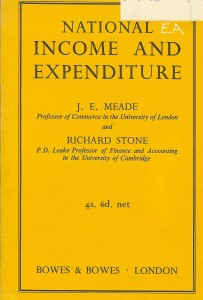A cold has turned my brain to cotton wool over the weekend, but I have been paging through a pamphlet that turned up courtesy of Abe Books, [amazon_link id=”B001OVBYXG” target=”_blank” ]National Income and Expenditure[/amazon_link] by J.E.Meade and Richard Stone. (I’ve got the 4th, 1957 edition; it was first published in 1944.) This is research for my next book, which is about GDP – contain your excitement. Modern national accounts manuals run to hundreds of dense pages. This first, crystal clear, description is 44 pages long.
It is startling, too, to be reminded how much the economy has changed. In 1954, personal consumer expenditure on food amounted to 21% of GNP at market prices, spending on communication services 0.45%. The percentages in 2011 were 5.5% and 1.3% respectively. Spending on clothing is down as a share, spending on entertainment up. We are living in difficult times, but these changed patterns are the measure of prosperity since the first systematic work on national accounts. It’s just as well that what might turn out to be a decade of GDP going backward came after a half-century going forward.

Meade and Stone

Looks like food costs have gone down a lot, but what about other non-discretionary expenditure: is there a comparison for housing costs, including fuel and water and especially actual and imputed rents of property?
Not huge detail but the share of some discretionary elements like entertainment, and recreational goods, has definitely gone up over time. I would need to look up housing figures – interesting question.
I’m sure you are, but will you be looking at the relationship between time and GDP in your new book? Jonathan Gershuny at Essex was (is?) always very interesting…
I will, albeit briefly. Time use surveys are really interesting and somewhere in them is a key to understanding service sector productivity.